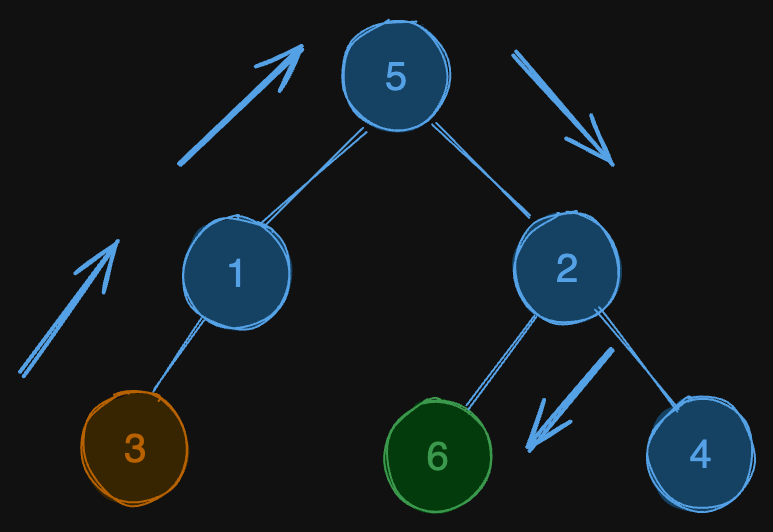Step-By-Step Directions From a Binary Tree Node to Another
Problem
You are given the root of a binary tree with n nodes. Each node is uniquely assigned a value from 1 to n. You are also given an integer startValue representing the value of the start node s, and a different integer destValue representing the value of the destination node t.
Find the shortest path starting from node s and ending at node t. Generate step-by-step directions of such path as a string consisting of only the uppercase letters 'L', 'R', and 'U'. Each letter indicates a specific direction:
'L'means to go from a node to its left child node.'R'means to go from a node to its right child node.'U'means to go from a node to its parent node.
Return the step-by-step directions of the shortest path from node s to node t.
Examples
Example 1:

Input: root = [5,1,2,3,null,6,4], startValue = 3, destValue = 6
Output: "UURL"
Explanation: The shortest path is: 3 → 1 → 5 → 2 → 6.
Example 2:
graph TD; 2 --- 1 2 ~~~ N1:::hidden style 2 fill:#FF9933 style 1 fill:#99FF33 classDef hidden display: none;
Input: root = [2,1], startValue = 2, destValue = 1
Output: "L"
Explanation: The shortest path is: 2 → 1.
Solution
To solve this problem, we need to find the shortest path from the node with startValue to the node with destValue in a binary tree. There are multiple ways to do so. One way can be that we use BFS for single source shortest path, but we have to create a binary tree with parent pointer in it, to store the relationships.
But another way can be we use the binary tree data structure and find LCA.
Method 1 - LCA
The main steps to achieve this are:
- Find the Node with the Given Values: We need to locate the nodes corresponding to
startValueanddestValue. - Determine the Lowest Common Ancestor (LCA): The LCA of the start and destination nodes helps in determining the shortest path between them. We have already seen [Lowest Common Ancestor of a Binary Tree](lowest-common-ancestor-of-a-binary-tree) here.
- Construct Paths from LCA to Start and Destination Nodes: Using Depth First Search (DFS), construct the paths from the LCA to both the start and destination nodes.
- Combine the Paths: Transform the path from start to LCA into 'U's and concatenate with the path from LCA to destination.
Code
Java
public class Solution {
public String getDirections(TreeNode root, int startValue, int destValue) {
// Step 1: Find the LCA of startValue and destValue
TreeNode lca = findLCA(root, startValue, destValue);
// Step 2: Find the path from LCA to startValue
StringBuilder pathToStart = new StringBuilder();
findPath(lca, startValue, pathToStart);
// Step 3: Find the path from LCA to destValue
StringBuilder pathToDest = new StringBuilder();
findPath(lca, destValue, pathToDest);
// Step 4: Convert pathToStart to all 'U's and combine paths
for (int i = 0; i < pathToStart.length(); i++) {
pathToStart.setCharAt(i, 'U');
}
// Combine paths
return pathToStart.toString() + pathToDest.toString();
}
private TreeNode findLCA(TreeNode root, int p, int q) {
if (root == null || root.val == p || root.val == q) {
return root;
}
TreeNode left = findLCA(root.left, p, q);
TreeNode right = findLCA(root.right, p, q);
if (left != null && right != null) {
return root;
}
return left != null ? left : right;
}
private boolean findPath(TreeNode root, int value, StringBuilder path) {
if (root == null) {
return false;
}
if (root.val == value) {
return true;
}
path.append('L');
if (findPath(root.left, value, path)) {
return true;
}
path.deleteCharAt(path.length() - 1);
path.append('R');
if (findPath(root.right, value, path)) {
return true;
}
path.deleteCharAt(path.length() - 1);
return false;
}
}
Complexity
- ⏰ Time complexity:
O(n)wherenis number of nodes in tree. - Each tree traversal forfindLCAandfindPathis O(n). - 🧺 Space complexity:
O(h)wherehis height of tree, and that comes from recursion stack. Space for the path strings will beO(h)as well.
Dry Run
Lets dry run with eg. 1 - root = [5,1,2,3,null,6,4], startValue = 3, destValue = 6
findLCA(root, 3,6) finds node with value 5.
Now, finding path from 5 to 3 is LL, and finding path from 5 to 6 returns RL.
Now, we convert LL to UU, and concatenate RL. Our path becomes UURL.